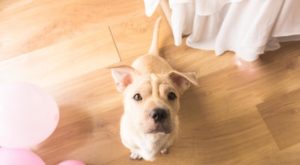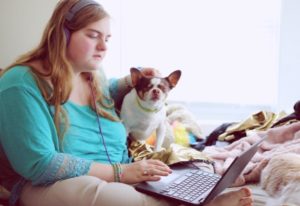How Long Can You Leave a Puppy or Dog Home Alone?
How Long Can You Leave a Puppy or Dog Home Alone?
Leaving your dog or puppy at home alone can be tricky. First-time dog parents can struggle to balance time with their pet, needing to work, and having a social life. Getting a puppy or dog is a serious commitment, and you can expect to lose a fair chunk of your free time, but that doesn’t mean you can’t leave them alone at all.
The following article is a general guide to help you navigate the complex emotions and behaviours your dog might exhibit if they feel they’re left alone for too long.
How long can you leave a puppy at home alone?
Puppies aged 8–10 weeks
One hour or less. You’ll end up with a wet floor if you leave a young puppy for more than an hour. You can begin crate training your puppy during this period, but if you leave them in the crate too long, they’ll only wet the bed.
Puppies aged 10–12 weeks
You can leave your pup for up to two hours at this stage of development, although you should slowly increase it rather than jumping to a full two hours. There’s no one size fits all strategy; some puppies might experience separation anxiety or act out if left for this long.

Puppies aged 3–6 months
Your puppy can be left alone for roughly one hour per month of age during this period if your dog seems okay with it upon your return.
Puppies aged over 6 months
An older puppy six months or older can likely hold their pee for up to six hours if trained. Still, dogs are pets that respond well to social time with their owners, so try to drop in on them if you can or have a pet sitter available.
How long can you leave a dog at home alone?
Adult dogs over 18 months old should be comfortable with being alone for 4-6 hours a day. An elderly dog should be okay with a similar timeframe. However, their bladder control may have weakened over time, or they might have another health concern which needs frequent tending or supervision.
Remember, these are all guides; no two dogs are the same (except for Barbara Streisand’s), so use your judgement based on your pet.
Leaving your dog home alone while at work
You can leave your dog home alone when you go to work but try to at least have someone come in and check on them if you can’t do it yourself.

Walking your dog early in the morning before you leave for work will burn off some excess energy and allow them to pee. Then your dog will be less likely to have an accident during the day or tear up the house for stimulation.
How to train your dog to stay home alone
As we said earlier, if you gradually extend the time you leave your puppy home alone during their development, they will be less likely to develop separation anxiety. Don’t throw the ball into the deep end and not show up for two hours the day your pup hits two months old, or they could be quite distressed.
What is separation anxiety in puppies and dogs?
Separation anxiety in dogs manifests after a pattern of being left alone too long or having their alone/in-company routine disrupted. It can take many forms, but your pup generally acts out when left alone.

Common Symptoms of Separation Anxiety
The following is a list of symptoms that may indicate separation anxiety:
Urinating and Defecating
It’s probably separation anxiety if your dog urinates or defecates while left alone. However, they may need additional training or to be let out to go more often. If your dog does these things in the house in front of you, it’s probably not separation anxiety.
Barking and Howling
Dogs will bark and howl when you leave; that’s normal. It’s prolonged spells of constant howling and barking without another external trigger that indicates separation anxiety.
Chewing, Digging, and Destruction
If your dog or puppy is suffering from separation anxiety, they may chew on things: their toys, the furniture, shoes, the house—really anything they can get their paws on. They might also try and dig, even if there’s nowhere to go, damaging sofas, carpets, floorboards, concrete floors, but more importantly, their paws and nails. These behaviours can damage their teeth and gums too. You’ll be able to tell if it’s separation anxiety if your dog doesn’t do any of these things when you’re around.
Escaping and Trying to Escape
When dogs are left alone and distressed, they might feel confined, so they try to escape. Being separated from their guardian can trigger this sequence of events. Again, if your dog doesn’t try and escape when you’re home, it means that separation anxiety is probably the reason.
Pacing
Dogs might pace in circles or up and down on repeat while alone if they have separation anxiety. Chasing their tails doesn’t count.
Coprophagia
If your dog eats their poop in front of you, they have an issue. It could also be a separation anxiety problem if they do this “doodoo dining” thing when you’re not around.
Why do some dogs develop separation anxiety?
Diagnosing dogs with mental health conditions is challenging, but there is some evidence of how separation anxiety develops in your pet. Dogs adopted from shelters are more likely to suffer these problems than pets raised from a puppy with the same family. It’s believed that the loss of their primary carer or guardian can trigger separation anxiety.
Other conditions noted to contribute to separation anxiety:
- Change of Guardian or Family
- Change in Schedule
- Change in Residence
- Change in Household Membership
- Medical Problems to Rule Out First
- Incontinence Caused by Medical Problems
- Medications
Other behaviour problems to rule out
There are some other behavioural problems which can mimic separation anxiety in dogs. It’s essential to rule them out so you can narrow down whether or not your pup is anxious.
They include:
- Submissive or Excitement Urination
- Incomplete House Training
- Urine Marking
- Juvenile Destruction
- Boredom
- Excessive Barking or Howling
You can read more about treating separation anxiety in dogs here.
Still unsure about committing to a dog? Check out our article on the unexpected benefits of having a dog.
Image credits:
Photo by Sophie Elvis on Unsplash
Photo by Sharon McCutcheon on Unsplash
Photo by fatty corgi on Unsplash


Leave a comment